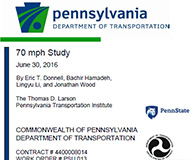8/2/2016
Pennsylvania Study Finds Higher Speed Limits Encourage Better CompliancePennsylvania Department of Transportation finds the primary effect of increasing the speed limit to 70 MPH was greater compliance.

It is often said that raising speed limits serves as an invitation to drivers to hit the gas and exceed the limit by an even greater margin. That was not the case in a Pennsylvania Department of Transportation (PennDOT) study released June 30. The report examined the effect of boosting the maximum legal speed on the Pennsylvania highways and toll roads to 70 MPH.
The agency hired consultants to use radar guns to sample traffic speeds at key road segments between two and ten months after the signs were changed compared to "before" figures gathered up to a year before the increase. Nearly three out of four motorists in the before period were technically violating the 65 MPH speed limit with an average speed of 68.5 MPH. The report showed that the only difference after the speed limit change was that it became harder to issue citations.
"The mean speed increased by 1.1 MPH for all vehicles in the study sample after increasing the posted speed limit from 65 to 70 MPH," the researchers found.
At 69.6 MPH, the average speed was in compliance with the 70 MPH limit in the "after" period. This compliance did not change over time, holding steady in speed checks performed just after the limit change and then a second check between nine and ten months after the change. The 85th percentile speed for the road, the speed at which 85 percent of traffic chooses to drive, was found to be 73.4 MPH for all vehicles, and 74.7 MPH for passenger automobiles, suggesting a 75 MPH speed limit would be appropriate to bring the percentage of "speeding" motorists down below 35 percent.
Traffic engineers have long believed that setting the speed limit at the 85th percentile speed was best, and that "slower" speeds were not necessarily safer. As the report explains, this was expressed in the 1964 Solomon curve (view graph), which showed that cars driving up to 10 MPH over the average speed of traffic had a significantly lower collision rate than those traveling below the prevailing speed of traffic. The accident risk from driving 10 MPH under the flow of traffic was found to be as dangerous as driving 20 MPH faster than the traffic flow. Subsequent studies by several researchers verified the findings.
The PennDOT report attempted to determine the safety impact of the speed limit change, but the researchers found the before and after results were so close that they were indistinguishable from random fluctuations in the crash data.
"The preliminary safety assessment completed for this project includes only 12 to 16 months of reported crash data after the speed limits were raised from 65 to 70 MPH," the report concluded. "Because crash data tend to be random and rare events, it is not possible to draw any preliminary conclusions from the before-after crash data."
The positive results inspired state officials to raise the speed limit to 70 MPH on 796 miles of highway a few weeks before the report was published.
A copy of the study is available in a 2mb PDF file at the source link below.


